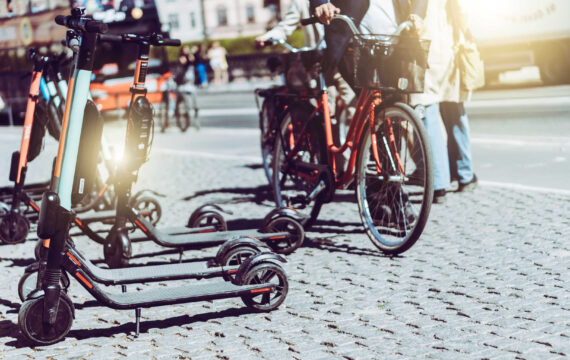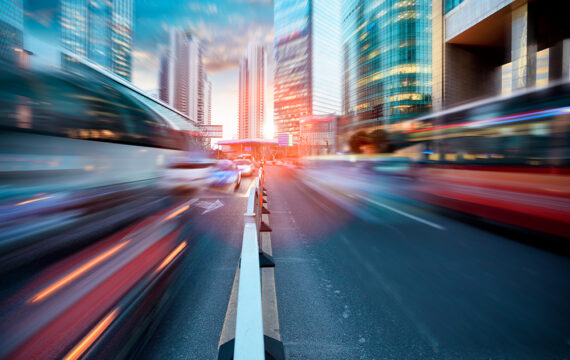Flying cars and drones for human transportation are no longer relegated to the science fiction of Blade Runner and the wildest ideas presented at tech events. Vertical Take-off and Landing (VTOL) aircraft such as passenger carrying drones, delivery drones, and air taxis are promising a whole new urban mobility concept: air mobility.

Atkinson places VTOL in the same category with autonomous driving, another technology destined to change the future of transportation once and for all. The development of VTOL aircraft started in 1983. There have been several massive air mobility breakthroughs along the way. Today, VTOL is predicted to bring huge changes to the passenger transportation market and urban mobility solutions development.
Predicted timeframe for commercial passenger drones

Source: Porsche Consulting – The Future of Vertical Mobility
The anticipated growth of the VTOL market is motivating OEMs, drone manufacturers, automakers, and technology solution providers to join the race for urban air mobility. Companies engaged in the development of VTOL technologies are focusing on various products like passenger drones, smaller drones for last-mile delivery and advertising services, flying cars, and revolutionary air vehicles. The lion’s share of air mobility market leaders have already passed the conceptualization stage.
Current stages of VTOL development among leading manufacturers

Source: Deloitte Insights
Urban air mobility will be an integral part of the transportation system in urban areas, tackling challenges with traffic jams, cost and space optimization, connections to rural areas, air pollution, and lethal incidents on the road.
Apart from that, VTOL combined with location data services brings even greater potential to delivery services. Just imagine buzzing swarms of drones shipping countless Amazon packages after Black Friday madness. Other commercial drone applications include building inspections, sky-based security, and maintenance and repair services.
Benefits of air transport across a range of services
- Higher speed means faster delivery and faster time of arrival
- Less investment required in infrastructure as no roads or railways are needed
- Access to areas regardless of landscape
- Few physical obstacles and distractions
- Decreased pollution thanks to electric energy sources (eVTOL)
Air taxis for transportation over long distances or drones for last-mile delivery? We’ll take them both
When discussing the benefits flying mobility can bring to transportation and delivery services, we should distinguish between the types of Vertical Take-off and Landing aircraft to be used for each type of service. Let’s take air transportation first.
Users of air taxis will get the most advantages from vertical mobility by commuting far distances such as from one city to another, from urban to rural areas, or from an airport to the city. The reason for this is that VTOL aircraft will still require passengers to access additional mobility services to get from their starting point to their final destination.
The customer journey for VTOL passengers

Source: Porsche Consulting
Even with these constraints, VTOL promises to be much faster than taxis, let alone public transportation on surface roads.
Comparison of travel time by road vs air, including direct connection and transfer

Source: Porsche Consulting
In the example above, we see that even the less optimistic scenario, in which commuters need to go to a vertiport or some other specially built infrastructure for takeoff and landing, minimizes travel time by 19 minutes while commuting from the Munich airport to Marienplatz in the city center. And as for the price, well, we have some forecasts from Daniel Wiegand, the CEO of Lilium, who lit up the stage at Web Summit.

To be on the same page as these bright minds in urban air mobility, check out this video from Web Summit.
If VTOL for transportation will be practical starting at distances of approximately 20 kilometers, lightweight drone delivery will work for short-distance flights. Also, drone delivery system will handle additional tasks.
Applications of drones in flying mobility
- Last-mile and express delivery
- Maintenance and repair services
- Cultivation and fertilization of urban and vertical farms
- Cargo transportation by drone fleets or bigger cargo drones
- Emergency delivery (medicine, organs)
- Hobby and semi-professional uses
- Media and entertainment
- Inspection and monitoring of building construction
- Security, locating people, and fraud detection
- Collection of images, scientific and mapping data
What technologies are behind urban air mobility?
When it comes to implementing revolutionary urban air mobility (UAM) ideas, we can do nothing without technology. Technological advancements can solve many challenges of VTOL ecosystems — save for obtaining certifications and complying with laws.
Challenges to solve for broad adoption of air mobility

In terms of technology, VTOL for transportation and drone delivery system will require a wide range of smart mobility solutions and digital spatial models to be implemented on the ground in addition to specific GIS and drones solutions for operation in the air.
Core technologies for successful air mobility and VTOL implementation
- Propulsion technologies using electric or hybrid energy sources. Technological advancements in propulsion will require collaborations and partnerships between manufacturers of drones, vehicles, aircraft, spare parts, energy suppliers, and providers of mobility services.
- Automation of aircraft based on artificial intelligence, sensors, and collected data. Unmanned aerial vehicles (UAVs) can already avoid geofenced areas and automatically detect objects in the way thanks to aerial maps and data-driven drone navigation platforms. By combining these technologies with advanced AI technologies used in autonomous driving and airplanes, vertical mobility companies can leap ahead of competitors at the early stages.
- Adoption of 5G networks to operate beyond urban areas. Wide-range and reliable connections will enable flying to mission-critical and distant objects to obtain mapping data, commuting between urban and rural areas, and delivering bulky items while avoiding urban areas to minimize risks.
- Integration of in-the-air and on-the-ground navigation for end-to-end routing. VTOL users will require additional means of transport to get to takeoff points and from landing spots to final destinations. Unified end-to-end navigation systems will play a critical role in building precise routes throughout the journey, including within buildings with landing zones on the roof.
- 3D mapping and geographic information system (GIS) technology for building accurate 3D maps for drones, taking into account the height of objects in the city and the overall landscape. To navigate in and near a city’s airspace, VTOL aircraft must rely on photogrammetry software and precise 3D maps with current data on the shapes and sizes of objects so nothing will take the aircraft by surprise.
- Collision avoidance systems (CAS) and air traffic management systems. Automated flights will depend on AI-driven systems to predict the behavior of other air traffic participants and act within uncertain environments while aligning the movements of all aircraft to avoid collisions.
- Fleet management solutions for monitoring and controlling aircraft. Just like vehicles on the ground, VTOL aircraft could form fleets for providing transportation services and drone delivery at scale. This would mean a need for tracking aircraft, monitoring their states, planning their schedules, and visualizing data on their performance.
- Weather predictions for safe movement and optimized passenger drone maintenance. Weather will be an issue for smaller delivery drones, as their low weight means they can’t withstand strong wind or heavy rain. Solutions for weather prediction will mitigate these risks and help service providers better plan estimated times for drone delivery.
How transport will look in 2035
With bold predictions that we’ll see the first commercial air taxis in 2025, we may claim that urban air mobility is underway. But as practice shows, it will take many more steps before this technology becomes affordable and accessible to everyone. The introduction of air mobility transportation and delivery services will look different depending on the bottlenecks each city struggles with. And for sure, VTOL aircraft will exist within a larger transportation ecosystem. Porsche Consulting offers a picture of transportation in cities by 2035, 10 years after they predict the first air taxis and passenger drones will go into service.
Air mobility as part of the transportation ecosystem by 2035

Opportunities of air mobility
Mobility is about moving people and goods around cities and to their destinations. For now, urban mobility mostly relies on public transportation — buses, trams, metros, trains — to carry commuters along the routes formed by a city’s infrastructure. Another piece of the pie is private cars and taxis, which navigate custom routes according to users’ needs. Add to this trucks delivering goods, soft modes of transportation like bicycles, and finally the rare helicopter to serve emergency or luxury needs.
Urban air mobility will allow cities to use all of these resources efficiently and reinforce the sharing economy by pooling air trips. It will also introduce new opportunities for integration of mobility as a service platforms and partnerships between public and private stakeholders to benefit regular citizens, municipalities and legal entities, hardware and software solution providers, and investors.
If you’re striving to contribute to the emerging air mobility sector through technical expertise in GIS, mapping, fleet management, or drone navigation solutions, consider Intellias as your software development partner. Get started by contacting our experts.



